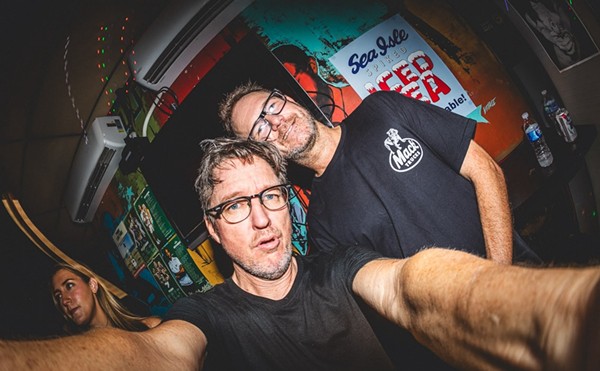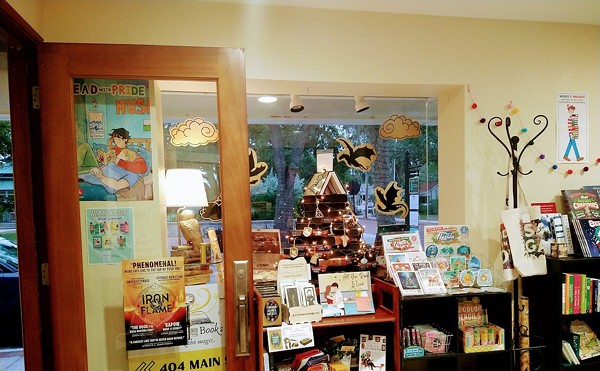Marks Made: Prints By American Women Artists from the 1960s to the Present Museum of Fine Arts
255 Beach Dr. NE, St. Petersburg, through Jan. 24, 2016. 727-896-2667, fine-arts.org.
What are the advantages of being a woman artist? Working without the pressure of success? Being reassured that whatever kind of art you make, it will be labeled feminine? Or being included in revised versions of art history (after being excluded from the canon for a lifetime)?
The list, emblazoned on a 1988 poster by the Guerrilla Girls — an artist collective famed for donning gorilla masks and pseudonyms to critique art world sexism — wouldn’t be so bitingly funny if these ironic honors didn’t ring at least somewhat true. If the feminist anger simmering beneath the faux-cheery inventory of benefits seems retro, it’s not because the situation has changed by much. In just the past two years, studies have indicated that women make up only 24 percent of museum directors at institutions with budgets over $15 million, and that female artists are outnumbered by men, 30 to 70 percent, on gallery rosters in New York and LA.
Katherine Pill, a curator at the Museum of Fine Arts, St. Petersburg, cites those statistics about the inequities faced by women in the art world in her exhibition catalogue for Marks Made: Prints By American Women Artists from the 1960s to the Present. The show, which features more than 90 prints by several dozen artists, ushers in the high point of the museum’s 50th anniversary year with evidence of the achievement of a bold goal: expanding the number of American women represented in the MFA’s permanent collection thanks to the generosity of donors Martha and Jim Sweeny, whose museum-assisted purchases and donations make up most of the works on view.
Five years in the making, that fun, smart and adventurous objective is now backed up by a fun, smart and adventurous exhibition.
The key to its success is the print — the relatively small and affordable piece of art th at, contrary to popular misconception, is no copy of a painting. Rather, it can be a virtuoso performance (often assisted by a technical team) in one of the many methods of printmaking that span from etching and lithography to screen printing, photogravure and monotype. That’s how Marks Made can encompass such strikingly different objects as Joan Mitchell’s “Flower I” (1981), a lithographic thicket of pink and orange scrawls punctuated with a hovering cloud of black and wisps of green, and Louise Nevelson’s “Sky Gate I” (1982), a pale gray molded paper piece that translates the sculptor’s monochromatic geometric constructions into a subtle relief.
The medium is what allows the museum to assemble a thrillingly thorough index of artists, from female pioneers of mid-century abstraction, like Helen Frankenthaler, to contemporary superstars like Kara Walker and Nicole Eisenman, and a handful who have lived in Tampa Bay, including Elisabeth Condon, Claudia Ryan, Marie Yoho Dorsey and Babs Reingold. The drawback, if there is one, is that prints can be diminutive and referential to an artist’s larger body of work — so that, for example, to really dig an intimate etching by Eisenman, in which two gender-ambiguous companions, a gorilla with a woman’s head and a blindfolded youth, traverse a dreamlike landscape, it helps to know her celebrated repertoire of disquieting figures and narratives.
The best pieces in the show are examples of this exquisite referencing. A mixed media print by Jessica Stockholder fuses disparate parts — relief printing, wood engraving, fake fur and upholstery — into a formal treat suggestive of her room-filling sculptural installations. A tiny print by Ellen Gallagher of a barely visible silhouette, dusted with a smattering of caricatured lips, evokes her interest in racial visual shorthand and the psychological impact of such symbols.
Less obviously, the exhibition also showcases women in the role of printer. June Wayne, the famed founder of Tamarind Lithography Workshop, is featured as an artist herself, while Kathan Brown of Crown Point Press hovers in the background as a shepherd of more than a few of the prints on view. Locally, Erika Greenberg Schneider, owner of Bleu Acier, is celebrated for her production of past works as well as new editions by Condon and Jane Hammond made especially for the exhibition. (Full disclosure: I work for the USF Institute for Research in Art, which encompasses Graphicstudio, a print studio prominently represented in the show, and is helmed by a female director.)
Most fun is when the show goes “meta” by pointing out its own activism through the work of the Guerrilla Girls. Their mass-produced posters are unusual among the other works, which emphasize the artists’ hand. But they provide a critical conceptual frame, welcoming visitors with an admonition (directed at an imaginary art collector) to buy more art by women… immediately. For a vivid example of how to, look no further than the MFA
















